Influence of Mouthwash Rinsing on the Mechanical Properties of Polymeric Ligature Ties Used for Dental Applications
Abstract
:1. Introduction
2. Materials and Methods
2.1. Sample Preparation
2.2. Universal Tensile Testing
2.3. Fourier-Transform Infrared Spectroscopy (FTIR)
2.4. Uniform Stretching Test
2.5. Scanning Electron Microscopy (SEM)
2.6. Statistical Analysis
3. Results
3.1. Sample Geometry
3.2. Universal Tensile Testing
3.3. Fourier-Transform Infrared Spectroscopy (FTIR)
3.4. Uniform Stretching Test
3.5. Scanning Electron Microscopy (SEM)
4. Discussion
4.1. Changes in Molecular Structure and Microscopic Morphology of Polymeric Orthodontic Ligature Ties
4.2. Reduction in the Maximum Force, Maximum Displacement, and Delivery Force of Polymeric Orthodontic Ligature Ties
4.3. Potential Surface Interactions between Mouthwash and Polymeric Orthodontic Ligature Ties and Future Studies
5. Conclusions
Author Contributions
Funding
Institutional Review Board Statement
Informed Consent Statement
Data Availability Statement
Acknowledgments
Conflicts of Interest
References
- Condò, R.; Casaglia, A.; Armellin, E.; Condò, S.G.; Cerroni, L. Traditional elastic ligatures versus slide ligation system. A morphological evaluation. Oral Implant. 2013, 6, 15–24. [Google Scholar] [CrossRef] [Green Version]
- Thorstenson, G.A.; Kusy, R.P. Effects of Ligation Type and Method on the Resistance to Sliding of Novel Orthodontic Brackets with Second-Order Angulation in the Dry and Wet States. Angle Orthod. 2003, 73, 418–430. [Google Scholar] [CrossRef]
- Rai, S.; Tikku, T.; Khanna, R.; Maurya, R.P.; Verma, S. Various methods of ligation ties. IP Indian J. Orthod. Dentofac. Res. 2019, 5, 5–10. [Google Scholar] [CrossRef]
- Papageorgiou, S.N.; Keilig, L.; Vandevska-Radunovic, V.; Eliades, T.; Bourauel, C. Torque differences due to the material variation of the orthodontic appliance: A finite element study. Prog. Orthod. 2017, 18, 6. [Google Scholar] [CrossRef] [PubMed] [Green Version]
- Higa, R.H.; Henriques, J.F.C.; Janson, G.; Matias, M.; de Freitas, K.M.S.; Henriques, F.P.; Francisconi, M.F. Force level of small diameter nickel-titanium orthodontic wires ligated with different methods. Prog. Orthod. 2017, 18, 21. [Google Scholar] [CrossRef] [PubMed] [Green Version]
- Behnaz, M.; Namvar, F.; Sohrabi, S.; Parishanian, M. Effect of Bleaching Mouthwash on Force Decay of Orthodontic Elastomeric Chains. J. Contemp. Dent. Pract. 2018, 19, 221–225. [Google Scholar] [CrossRef]
- Articolo, L.C.; Kusy, R.P. Influence of angulation on the resistance to sliding in fixed appliances. Am. J. Orthod. Dentofac. Orthop. 1999, 115, 39–51. [Google Scholar] [CrossRef]
- Barros, S.E.; Vanz, V.; Chiqueto, K.; Janson, G.; Ferreira, E. Mechanical strength of stainless steel and titanium alloy mini-implants with different diameters: An experimental laboratory study. Prog. Orthod. 2021, 22, 9. [Google Scholar] [CrossRef]
- Galvão, M.B.; Camporesi, M.; Tortamano, A.; Dominguez, G.C.; Defraia, E. Frictional resistance in monocrystalline ceramic brackets with conventional and nonconventional elastomeric ligatures. Prog. Orthod. 2013, 14, 9. [Google Scholar] [CrossRef] [Green Version]
- Sujaritwanid, K.; Suzuki, B.; Suzuki, E.Y. Comparison of one versus two maxillary molars distalization with iPanda: A finite element analysis. Prog. Orthod. 2021, 22, 12. [Google Scholar] [CrossRef]
- Mummolo, S.; Tieri, M.; Nota, A.; Caruso, S.; Darvizeh, A.; Albani, F.; Gatto, R.; Marzo, G.; Marchetti, E.; Quinzi, V.; et al. Salivary concentrations of Streptococcus mutans and Lactobacilli during an orthodontic treatment. An observational study comparing fixed and removable orthodontic appliances. Clin. Exp. Dent. Res. 2020, 6, 181–187. [Google Scholar] [CrossRef] [Green Version]
- Lu, H.; Tang, H.; Zhou, T.; Kang, N. Assessment of the periodontal health status in patients undergoing orthodontic treatment with fixed appliances and Invisalign system: A meta-analysis. Medicine 2018, 97. [Google Scholar] [CrossRef] [PubMed]
- Kamikawa, Y.; Hirabayashi, D.; Nagayama, T.; Fujisaki, J.; Hamada, T.; Sakamoto, R.; Kamikawa, Y.; Sugihara, K. In Vitro Antifungal Activity against Oral Candida Species Using a Denture Base Coated with Silver Nanoparticles. J. Nanomater. 2014, 2014, 780410. [Google Scholar] [CrossRef] [Green Version]
- Bauer Faria, T.R.; Furletti-Goes, V.F.; Franzini, C.M.; de Aro, A.A.; de Andrade, T.A.M.; Sartoratto, A.; de Menezes, C.C. Anti-inflammatory and antimicrobial effects of Zingiber officinale mouthwash on patients with fixed orthodontic appliances. Am. J. Orthod. Dentofac. Orthop. 2021, 159, 21–29. [Google Scholar] [CrossRef]
- Raju, R.; Divya, A.; Rajendran, G.; John, J.R. Analogous assay between green tea mouthwash, listerine mouthwash and chlorhexidine mouthwash in plaque reduction, on orthodontic patients: A randomized cross-over study. Int. J. Community Med. Public Health 2017, 4, 1429–1435. [Google Scholar] [CrossRef] [Green Version]
- Geramy, A.; Hooshmand, T.; Etezadi, T. Effect of Sodium Fluoride Mouthwash on the Frictional Resistance of Orthodontic Wires. Front. Dent. 2017, 14, 254–258. [Google Scholar]
- Bhushan, R.; Ramanna, P.K.; Kumar, S.; Thakkar, R.; Singh, P.; Nigam, M. Impact of Fluoridated and Non-fluoridated Mouth Rinses on Frictional Resistance between Orthodontic Archwire and Bracket: A Comparative Study. J. Contemp. Dent. Pract. 2020, 21, 1337–1341. [Google Scholar] [CrossRef]
- Alwafe, N.A.; Hammad, S.M.; El-wassefy, N.A.; Hafez, A.M. Evaluation of the Effect of an Experimental Herbal versus Fluoridated Mouthwash on Frictional Resistance and Surface Roughness between Orthodontic Brackets and Two Types of Archwire: In Vitro Study. J. Dent. Mater. Tech. 2019, 8, 205–214. [Google Scholar] [CrossRef]
- Fatimah, D.I.; Anggani, H.S.; Ismah, N. Effect of fluoride mouthwash on tensile strength of stainless steel orthodontic archwires. J. Phys. Conf. Ser. 2017, 884, 012102. [Google Scholar] [CrossRef] [Green Version]
- Felipucci, D.N.B.; Curylofo, P.A.; Crizóstomo, L.C.; Vaz, L.G.; Alves, S.d.V.; Macedo, A.P.; Pagnano, V.O. Effect of Cleanser Solutions on the Retention Force of O ring Attachment: An in Vitro Study. Braz. Dent. J. 2020, 31, 657–663. [Google Scholar] [CrossRef] [PubMed]
- Nakhaei, S.; Agahi, R.H.; Aminian, A.; Rezaeizadeh, M. Discoloration and force degradation of orthodontic elastomeric ligatures. Dent. Press J. Orthod. 2017, 22, 45–54. [Google Scholar] [CrossRef] [Green Version]
- Dechkunakorn, S.; Viriyakosol, N.; Anuwongnukroh, N.; Suddhasthira, T.; Laokijcharoen, P.; Churnjitapirom, P.; Tua-Ngam, P.; Kaewprakob, T. Residual Force of Orthodontic Elastomeric Ligature. Adv. Mater. Res. 2011, 378–379, 674–680. [Google Scholar] [CrossRef]
- Schneider, C.A.; Rasband, W.S.; Eliceiri, K.W. NIH Image to ImageJ: 25 years of image analysis. Nat. Methods 2012, 9, 671–675. [Google Scholar] [CrossRef]
- Kovatch, J.S.; Lautenschlager, E.P.; Apfel, D.A.; Keller, J.C. Load-Extension-Time Behavior of Orthodontic Alastiks. J. Dent. Res. 1976, 55, 783–786. [Google Scholar] [CrossRef]
- Chen, Y.; Zou, C.; Mastalerz, M.; Hu, S.; Gasaway, C.; Tao, X. Applications of Micro-Fourier Transform Infrared Spectroscopy (FTIR) in the Geological Sciences—A Review. Int. J. Mol. Sci. 2015, 16, 30223–30250. [Google Scholar] [CrossRef] [PubMed]
- Khan, S.A.; Khan, S.B.; Khan, L.U.; Farooq, A.; Akhtar, K.; Asiri, A.M. Fourier Transform Infrared Spectroscopy: Fundamentals and Application in Functional Groups and Nanomaterials Characterization. In Handbook of Materials Characterization; Sharma, S.K., Ed.; Springer International Publishing: Cham, Switzerland, 2018; pp. 317–344. [Google Scholar]
- Rangel-Vazquez, N.-A.; Sánchez-López, C.; Felix, F.R. Spectroscopy analyses of polyurethane/polyaniline IPN using computational simulation (Amber, MM+ and PM3 method). Polímeros 2014, 24, 453–463. [Google Scholar] [CrossRef] [Green Version]
- Su, K.-H.; Su, C.-Y.; Cho, C.-T.; Lin, C.-H.; Jhou, G.-F.; Chang, C.-C. Development of Thermally Conductive Polyurethane Composite by Low Filler Loading of Spherical BN/PMMA Composite Powder. Sci. Rep. 2019, 9, 14397. [Google Scholar] [CrossRef] [PubMed] [Green Version]
- Dias, R.C.M.; Góes, A.M.; Serakides, R.; Ayres, E.; Oréfice, R.L. Porous biodegradable polyurethane nanocomposites: Preparation, characterization, and biocompatibility tests. Mater. Res. 2010, 13, 211–218. [Google Scholar] [CrossRef]
- Dempsey, D.K.; Carranza, C.; Chawla, C.P.; Gray, P.; Eoh, J.H.; Cereceres, S.; Cosgriff-Hernandez, E.M. Comparative analysis of in vitro oxidative degradation of poly(carbonate urethanes) for biostability screening. J. Biomed. Mater. Res. A 2014, 102, 3649–3665. [Google Scholar] [CrossRef]
- Romanczyk, M.; Ramirez Velasco, J.H.; Xu, L.; Vozka, P.; Dissanayake, P.; Wehde, K.E.; Roe, N.; Keating, E.; Kilaz, G.; Trice, R.W.; et al. The capability of organic compounds to swell acrylonitrile butadiene O-rings and their effects on O-ring mechanical properties. Fuel 2019, 238, 483–492. [Google Scholar] [CrossRef]
- Szabó, G.; Váradii, K. Large Strain Viscoelastic Material Model for Deformation, Stress and Strain Analysis of O-rings. Period. Polytech. Mech. Eng. 2018, 62, 148–157. [Google Scholar] [CrossRef] [Green Version]
- Kundera, C.; Bochnia, J. Investigating the stress relaxation of photopolymer O-ring seal models. Rapid Prototyp. J. 2014, 20, 533–540. [Google Scholar] [CrossRef]
- Buchmann, N.; Senn, C.; Ball, J.; Brauchli, L. Influence of initial strain on the force decay of currently available elastic chains over time. Angle Orthod. 2011, 82, 529–535. [Google Scholar] [CrossRef]
- Malanon, S.; Dechkunakorn, S.; Anuwongnukroh, N.; Sea-Oui, P.; Thaptong, P.; Wicha, W. Mechanical Properties of Experimental Non-Latex Orthodontic Elastic Bands. Appl. Mech. Mater. 2020, 897, 185–189. [Google Scholar] [CrossRef]
- Malanon, S.; Dechkunakorn, S.; Anuwongnukroh, N.; Wichai, W. Comparison of Three Commercial Latex and Non-Latex Orthodontic Elastic Bands. Key Eng. Mater. 2019, 814, 354–359. [Google Scholar] [CrossRef]
- Pureprasert, T.; Anuwongnukroh, N.; Dechkunakorn, S.; Loykulanant, S.; Kongkaew, C.; Wichai, W. Comparison of Mechanical Properties of Three Different Orthodontic Latex Elastic Bands Leached with NaOH Solution. Key Eng. Mater. 2017, 730, 135–140. [Google Scholar] [CrossRef]
- Sokolov, A.K.; Garishin, O.K.; Svistkov, A.L.v. A new hypothesis on the mechanism of nano-filled elastomers reinforcement. Mech. Adv. Mater. Mod. Process. 2018, 4, 7. [Google Scholar] [CrossRef]
- Bovas, B.C.; Karunamoorthy, L.; Chuan, F.B. Effect of surface roughness and process parameters on mechanical properties of fabricated medical catheters. Mater. Res. Express 2020, 6, 125420. [Google Scholar] [CrossRef]
- Lacerda dos Santos, R.; Pithon, M.M.; Romanos, M.T.V. The influence of pH levels on mechanical and biological properties of nonlatex and latex elastics. Angle Orthod. 2011, 82, 709–714. [Google Scholar] [CrossRef] [Green Version]
- Pithon, M.M.; Rodrigues, A.C.; Sousa, É.L.S.M.; de Souza Santos, L.P.; dos Santos Soares, N. Do mouthwashes with and without bleaching agents degrade the force of elastomeric chains? Angle Orthod. 2013, 83, 712–717. [Google Scholar] [CrossRef] [Green Version]
- Larrabee, T.M.; Liu, S.S.-Y.; Torres-Gorena, A.; Soto-Rojas, A.; Eckert, G.J.; Stewart, K.T. The effects of varying alcohol concentrations commonly found in mouth rinses on the force decay of elastomeric chain. Angle Orthod. 2012, 82, 894–899. [Google Scholar] [CrossRef]
- Mahajan, V.; Singla, A.; Negi, A.; Jaj, H.S.; Bhandari, V. Influence of Alcohol and Alcohol-free Mouthrinses on Force Degradation of Different Types of Space Closure Auxiliaries used in Sliding Mechanics. J. Indian Orthod. Soc. 2014, 48, 546–551. [Google Scholar] [CrossRef]
- Gawliński, M. Friction and wear of elastomer seals. Arch. Civ. Mech. Eng. 2007, 7, 57–67. [Google Scholar] [CrossRef]
- Ardeshna, A.P.; Vaidyanathan, T.K. Colour changes of orthodontic elastomeric module materials exposed to in vitro dietary media. J. Orthod. 2009, 36, 177–185. [Google Scholar] [CrossRef] [PubMed]
- Oliveira, A.S.; Kaizer, M.R.; Salgado, V.E.; Soldati, D.C.; Silva, R.C.; Moraes, R.R. Influence of Whitening and Regular Dentifrices on Orthodontic Clear Ligature Color Stability. J. Esthet. Restor. Dent. 2015, 27, S58–S64. [Google Scholar] [CrossRef] [PubMed]
- Kim, S.-H.; Lee, Y.-K. Measurement of discolouration of orthodontic elastomeric modules with a digital camera. Eur. J. Orthod. 2009, 31, 556–562. [Google Scholar] [CrossRef]
- Tua-ngam, P.; Jira-anankul, N.; Anuwongnukroh, N.; Dechkunakorn, S.; Laokijcharoen, P. Cytotoxicity of three commercial orthodontic elastomeric ligature brands. MATEC Web Conf. 2017, 108, 06004. [Google Scholar] [CrossRef] [Green Version]
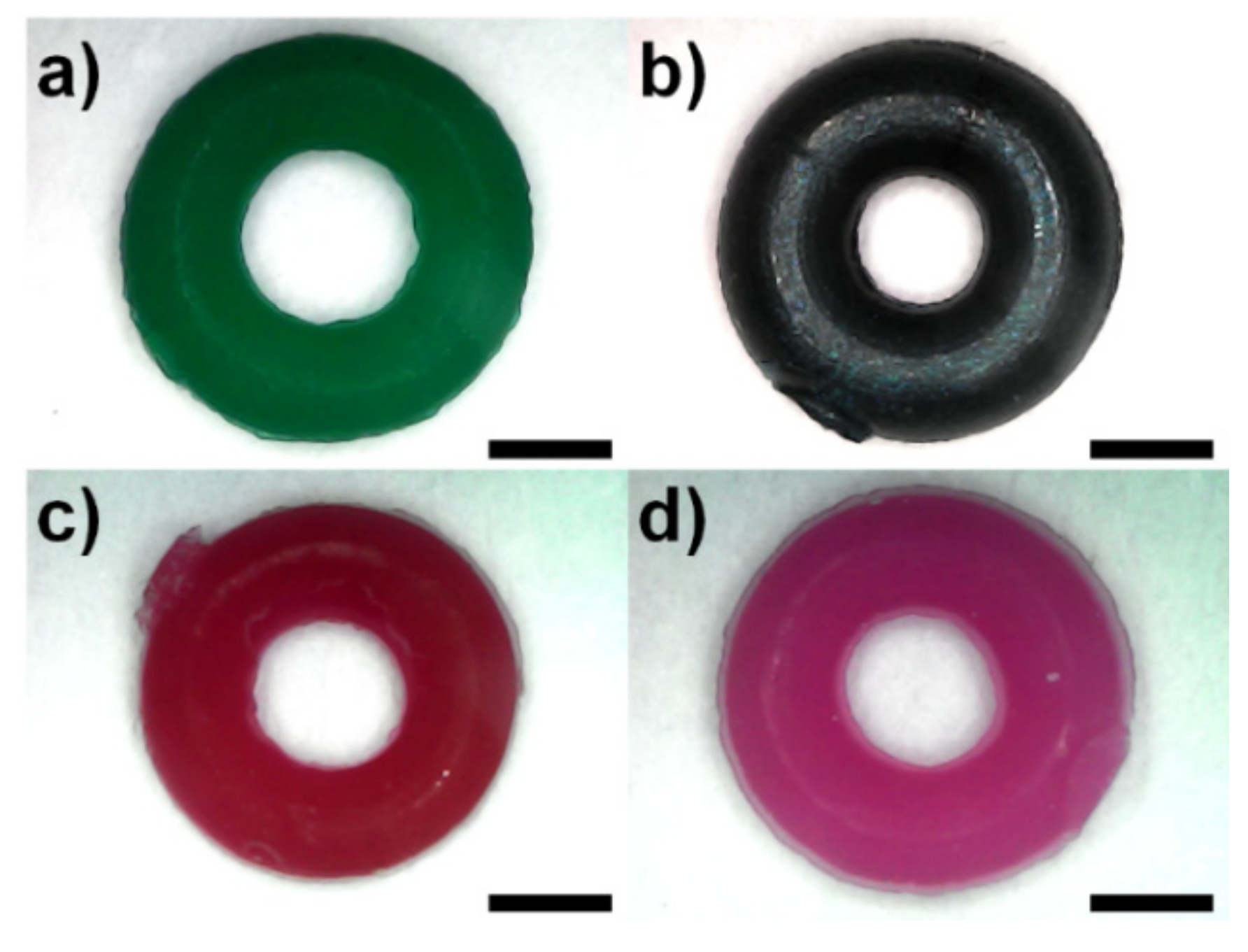
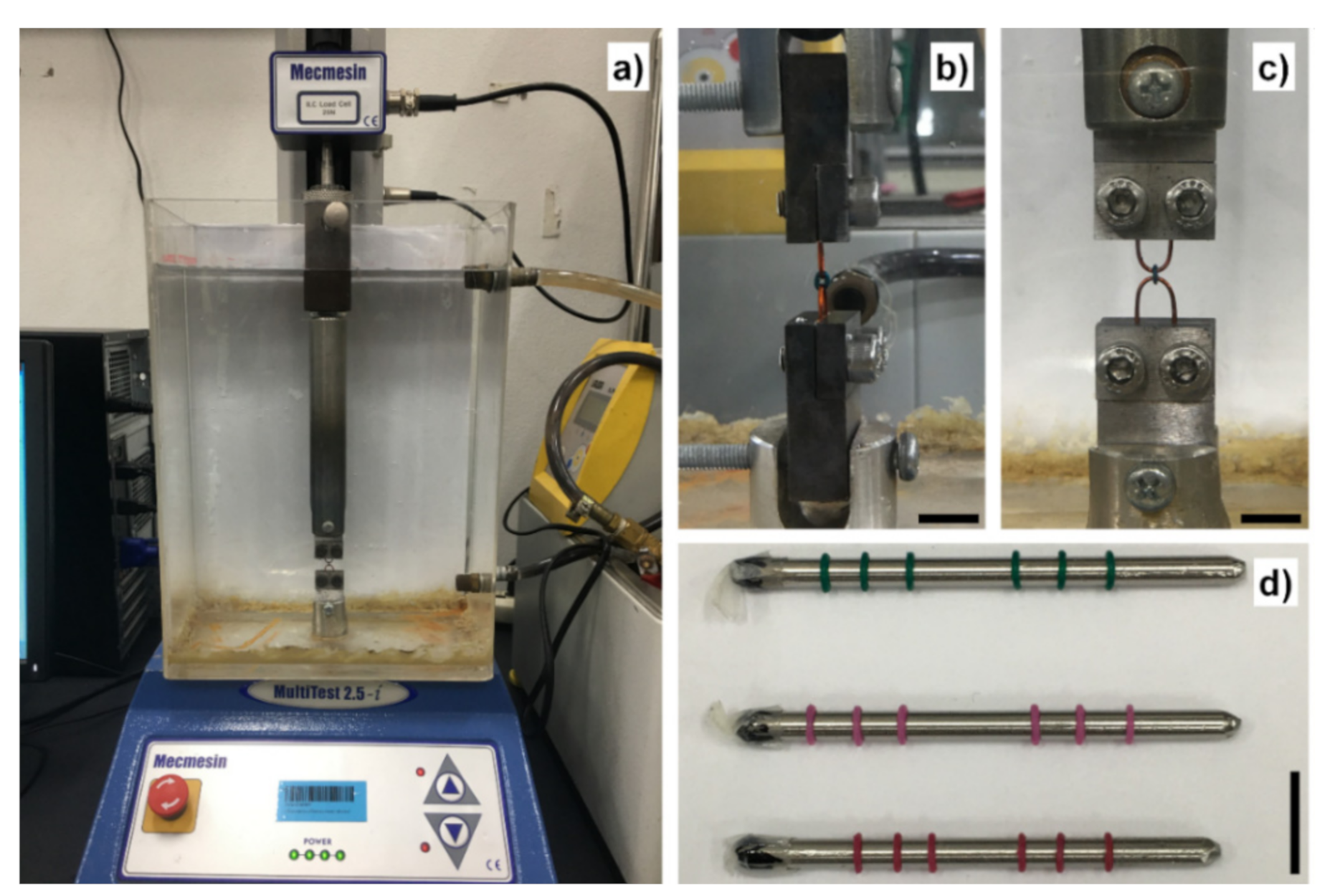


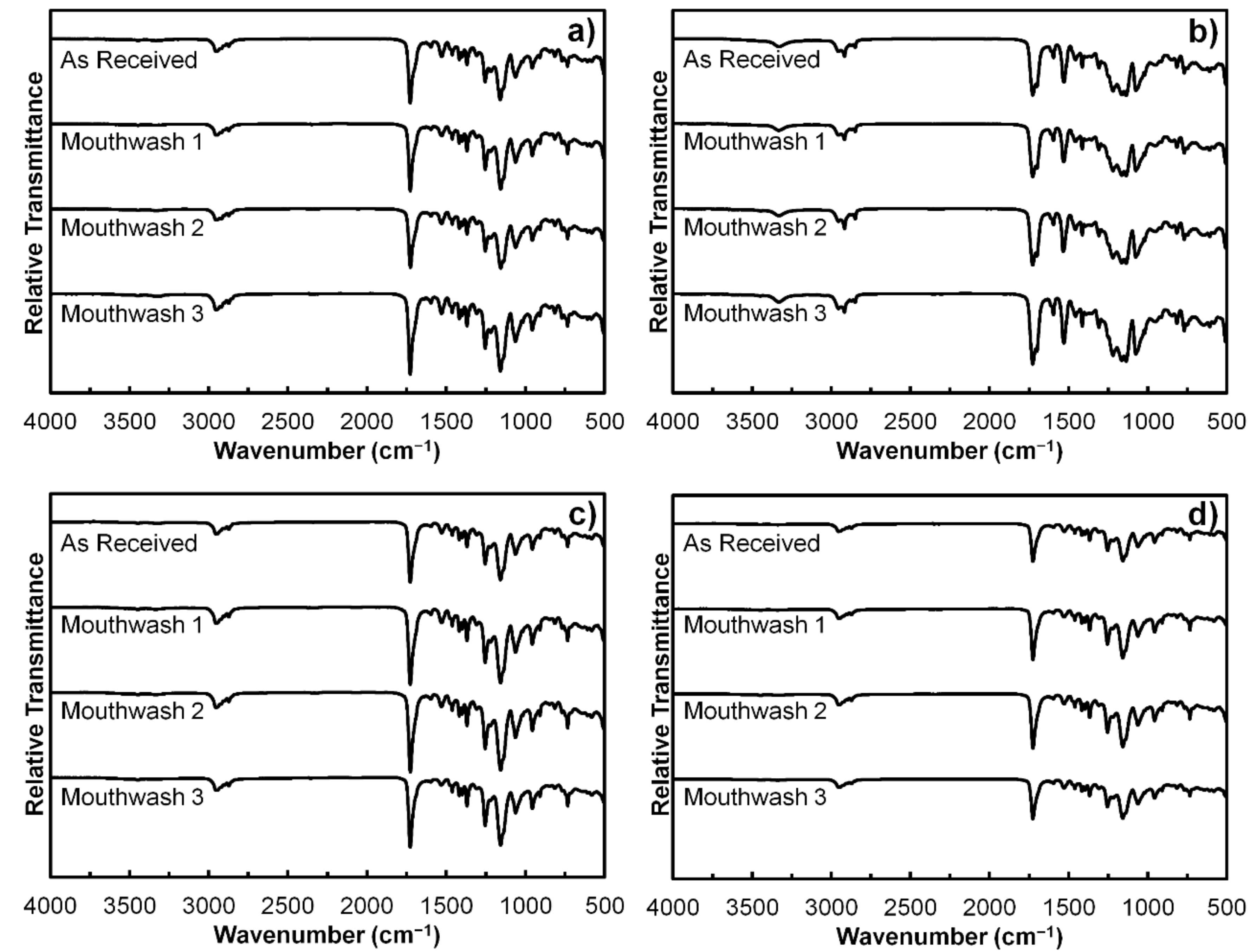
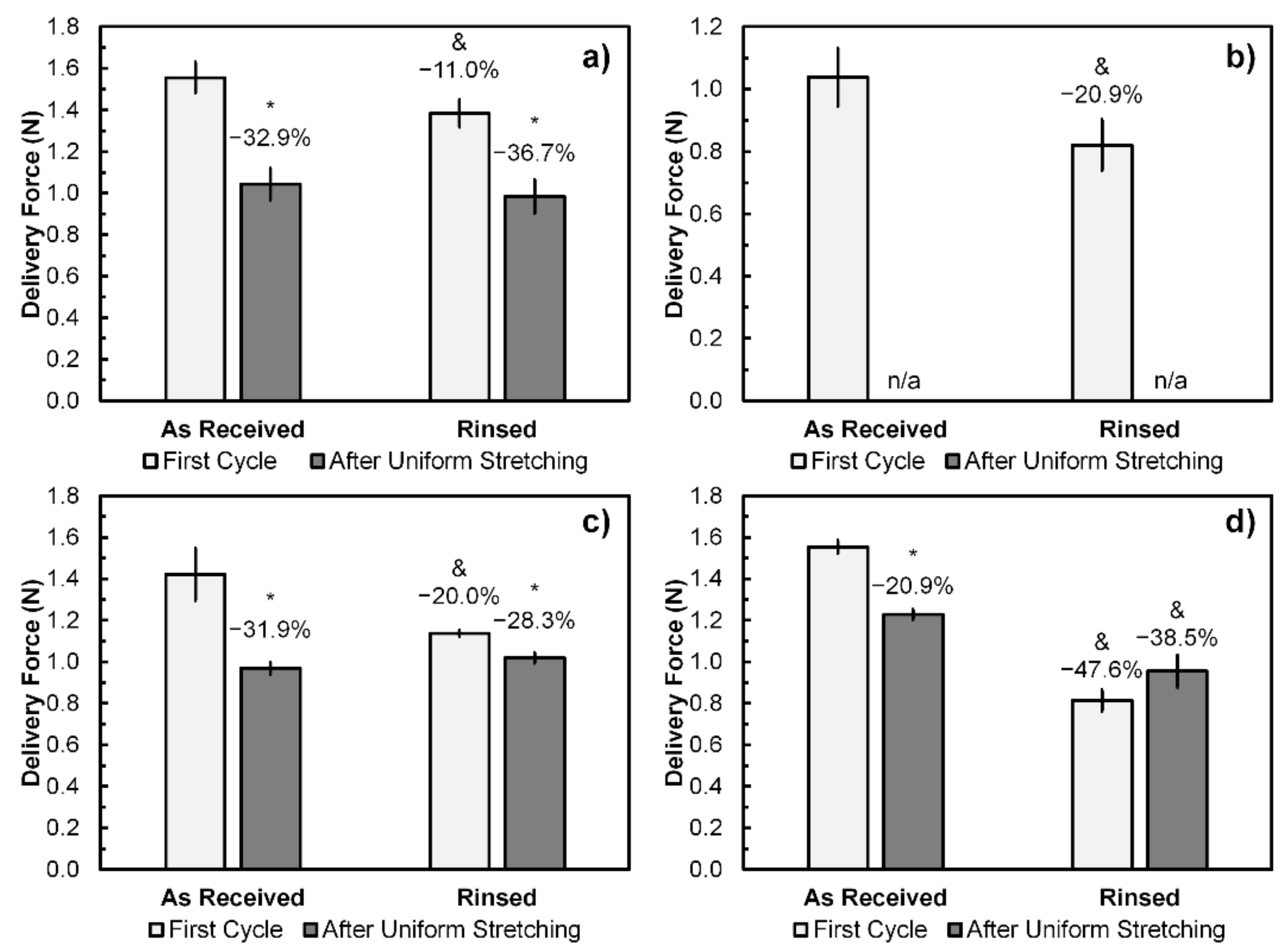
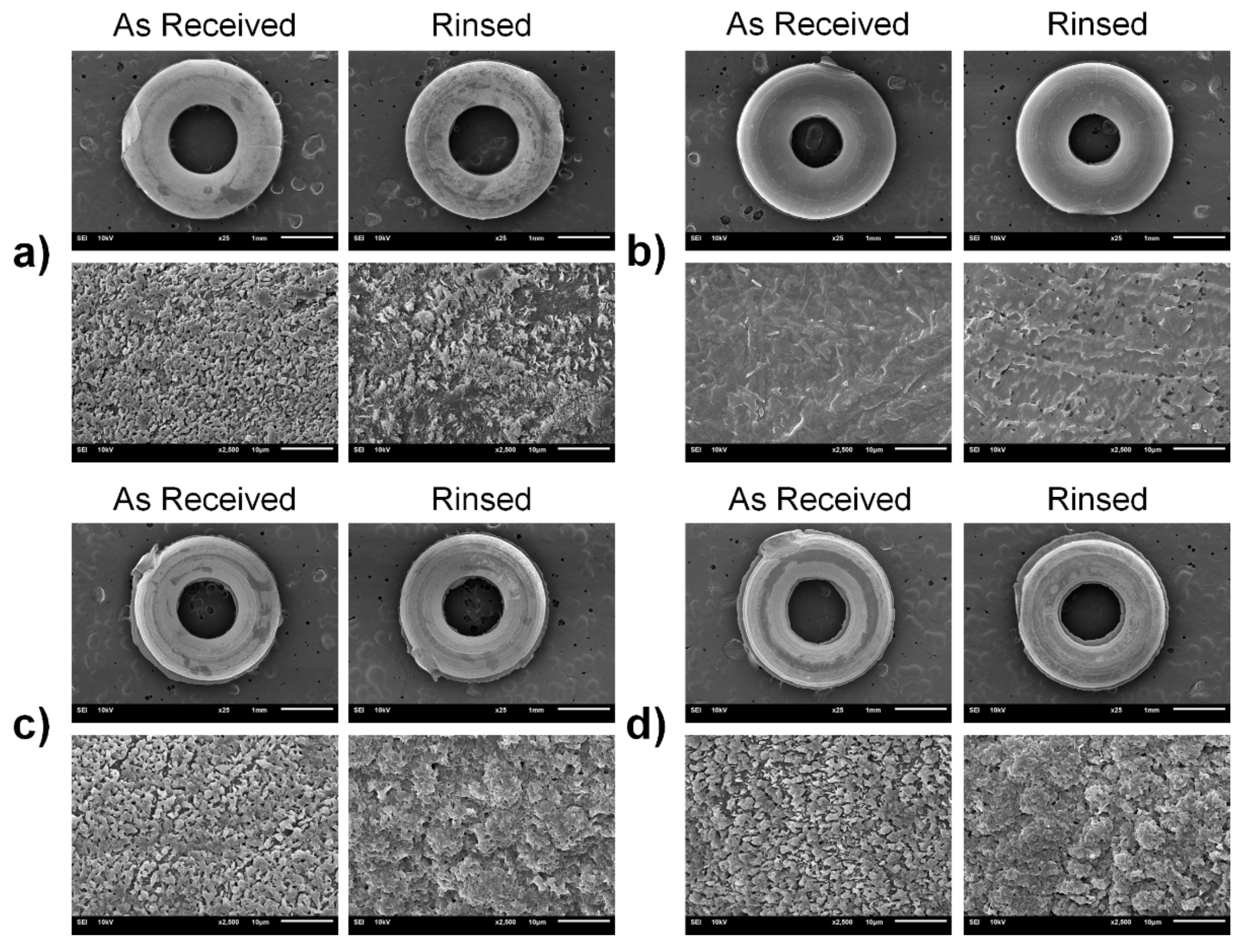
| Labels | Ingredients Listed on the Label | |||
|---|---|---|---|---|
| Mouthwash 1 (Colgate® Plax® Peppermint, Bangkok, Thailand) | Water | Sodium fluoride | Poloxamer 407 | Menthol |
| Flavor | Glycerin | Propylene glycol | Sorbitol | |
| Sodium saccharin | Cetylpyridinium chloride | Potassium sorbate | CI 42051 | |
| Mouthwash 2 (Listerine® Cool Mint, Bangkok, Thailand) | Water | Benzoic acid | Poloxamer 407 | Menthol |
| Flavor | Methyl salicylate | Eucalyptol | Sorbitol | |
| Sodium saccharin | CI 42053 | Thymol | Alcohol | |
| Sodium benzoate | ||||
| Mouthwash 3 (Fluocaril®, Bi-Fluoré Ortho 123, Bangkok, Thailand) | Water | Sodium fluoride | PPG-26 Buteth-26 | Xylitol |
| Flavor | Glycerin | PEG-40 Hydrogenated Castor Oil | Panthenol | |
| Sodium saccharin | Cetylpyridinium chloride | Sodium Monofluorophosphate | CI 14720 | |
| Sodium benzoate | Aloe barbadensis leaf extract | Centella asiatica extract | CI 16255 | |
| Citric acid | ||||
| Labels | Inner Diameter (mm) Mean ± SD (n = 5) | Outer Diameter (mm) Mean ± SD (n = 5) | Thickness (mm) Mean ± SD (n = 5) |
|---|---|---|---|
| Brand A (Dentsply Sirona, Charlotte, North Carolina, USA) | 1.476 ± 0.083 | 3.318 ± 0.151 | 0.778 ± 0.008 |
| Brand B (Dent-Mate Co., Ltd., Bangkok, Thailand) | 1.160 ± 0.045 | 3.206 ± 0.120 | 0.762 ± 0.004 |
| Brand C (DynaFlex®, St. Ann, Missouri, USA) | 1.292 ± 0.040 | 3.061 ± 0.084 | 0.716 ± 0.009 |
| Brand D (Skyortho Dental Supplies Medical Co., Ltd., Yancheng, China) | 1.334 ± 0.118 | 3.081 ± 0.199 | 0.835 ± 0.007 |
Publisher’s Note: MDPI stays neutral with regard to jurisdictional claims in published maps and institutional affiliations. |
© 2021 by the authors. Licensee MDPI, Basel, Switzerland. This article is an open access article distributed under the terms and conditions of the Creative Commons Attribution (CC BY) license (https://creativecommons.org/licenses/by/4.0/).
Share and Cite
Phukaoluan, A.; Khantachawana, A.; Dechkunakorn, S.; Anuwongnukroh, N.; Tunthawiroon, P.; Srirussamee, K. Influence of Mouthwash Rinsing on the Mechanical Properties of Polymeric Ligature Ties Used for Dental Applications. Polymers 2021, 13, 2236. https://doi.org/10.3390/polym13142236
Phukaoluan A, Khantachawana A, Dechkunakorn S, Anuwongnukroh N, Tunthawiroon P, Srirussamee K. Influence of Mouthwash Rinsing on the Mechanical Properties of Polymeric Ligature Ties Used for Dental Applications. Polymers. 2021; 13(14):2236. https://doi.org/10.3390/polym13142236
Chicago/Turabian StylePhukaoluan, Aphinan, Anak Khantachawana, Surachai Dechkunakorn, Niwat Anuwongnukroh, Phacharaphon Tunthawiroon, and Kasama Srirussamee. 2021. "Influence of Mouthwash Rinsing on the Mechanical Properties of Polymeric Ligature Ties Used for Dental Applications" Polymers 13, no. 14: 2236. https://doi.org/10.3390/polym13142236






